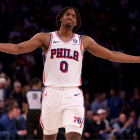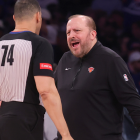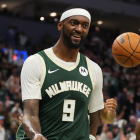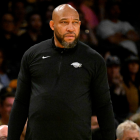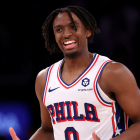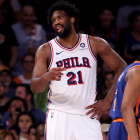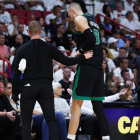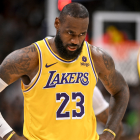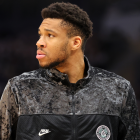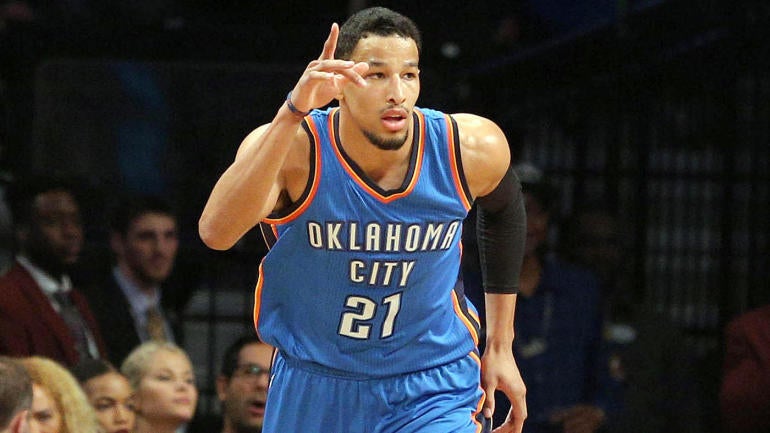
There is something very precarious about the Oklahoma City Thunder's success this season. They hardly ever blow teams out, instead relying on their steady diet of fourth-quarter mid-range jumpers to bury opponents in the final minutes. No team is ever going to outscore opponents by 30 points per 100 possessions in clutch situations over a meaningful sample. There is similar regression coming on defense, where opponents have hit only 36.3 percent of their wide-open 3-pointers, the fourth-lowest mark in the NBA. Dennis Schroder is going to start missing eventually.
Some of those pillars are sturdier than others. Chris Paul teams almost always own fourth quarters, and they typically fall on the right end of the variance spectrum through the dozens of invisible ways he adds value. But Oklahoma City's statistical indicators are so out of whack this season that the Thunder stand out as a sort of statistical Jenga tower. They lack the margin of error typically afforded contenders by virtue of raw talent. One piece out of place threatens to collapse their entire feel-good run, and for most of the season, the likeliest culprits have been Oklahoma City's wings.
Only three members of the Thunder have played at least 500 minutes and posted a negative net rating. Terrance Ferguson, Abdel Nader and Darius Bazley are all functionally wings. The Thunder aren't much better with Hamidou Diallo on the floor, outscoring opponents by only 1.9 points per 100 possessions. Oklahoma City has so struggled to fill those perimeter minutes that, aside from Danilo Gallinari and the surprising Luguentz Dort, it has essentially punted on the position altogether when it counts. Only five Thunder lineups have played at least 75 minutes this season. Two of them feature three point guards -- Paul, Schroder and Shai Gilgeous-Alexander -- and those units have both blasted opponents by over 20 points per 100 possessions. The other three have all been outscored. The point guards have mostly monopolized crunch time.
Bazley is a rookie, and rookies tend not to be able to contribute to winners. Nader essentially makes the minimum. Diallo is a raw second-round pick. You get what you pay for. A quirk of the Thunder's accidental foray into contention is the emphasis they placed on low-risk, high-reward developmental prospects hindering their unexpected short-term ambitions.
Fortunately, Oklahoma City's more experienced and expensive cavalry is on the way. Andre Roberson has not played since Jan. 27, 2018 due to a string of injuries that began with a gruesome ruptured patellar tendon, but he is listed on Oklahoma City's official roster for Disney. He has been practicing with the Thunder in Orlando, and the reviews have been positive.
"He's doing great," coach Billy Donovan said after Sunday's practice. "I think he's gaining confidence. I think he's got confidence in where he's at physically. I think he's trying to gain confidence right now in terms of being out from playing competitive basketball for two years."
Take everything beyond this point with the requisite dozen or two grains of salt. There is no telling what any player will look like after two-and-a-half years of rehab, and the Thunder haven't publicly commented on his availability in any way. But a reasonably healthy and effective version of Roberson fills a number of Oklahoma City's most pressing needs.
That starts on defense, where Oklahoma City's three-headed point guard monster is deficient in exactly the ways you'd imagine it to be. The Thunder struggle to contain bigger ball-handlers, and as a result, are ranked 24th in the NBA in pick-and-roll defense and 16th against isolation, according to Synergy Sports. Giannis Antetokounmpo has played them twice and shot over 66 percent from the field in those matchups. Though Roberson hasn't faced this fully realized version of Giannis, he had no trouble with the physicality of the younger model, successfully deterring a drive and extending out long and quickly enough to knock away his exit valve pass below:
Roberson's last season-and-a-half was filled with such highlights. Nobody gets to the basket against him consistently, not even LeBron James:
Every night, a different perimeter star was turned away, often comically. Watch as Pau Gasol considers screening Roberson on Kawhi Leonard before admitting defeat:
What scared Gasol off? Roberson navigates through screens so expertly that there's hardly a point in using them. Watch as Clint Capela tries and fails to spring James Harden:
Roberson matches elite physical dimensions with reflexes straight out of "The Matrix," and the result, when healthy, was a Defensive Player of the Year Candidate. The trade-off for that defense, in theory, has been offense. There's something to that on paper, as Roberson is among the worst shooters in basketball (though, for the optimists in the crowd, "he's shooting the ball better than he's ever shot" according to Nader). But in terms of team performance, there isn't much evidence suggesting that Roberson's lack of shooting makes offenses materially worse.
Oklahoma City's offense was 3.1 points per 100 possessions better with Roberson on the floor during the 2016-17 season, and was essentially even with or without him during the 2015-16 campaign. There is noise inherent in those numbers, as Roberson historically spent the majority of his minutes tethered to Russell Westbrook and the pre-Schroder Thunder were notoriously bad at picking backup point guards, but that raises its own questions. Westbrook and Roberson stood out in a spacing-obsessed NBA as perhaps the league's worst shooting backcourt ... yet still held its own offensively even without being flanked by Kevin Durant or Paul George.
Roberson's contribution to that effort came in his development off the ball. After years of being ignored entirely by defenses, he grew into an elite cutter. Though it was the play responsible for his fluke injury, he developed a particular aptitude for backdooring his way into lobs from Westbrook:
This is the simplest antidote to a lack of shooting. If defenses use your man as a rover, punish him for it by taking free runs to the basket when he isn't looking. It's a lesson Oklahoma City's other wings have yet to learn. Ferguson has disappointed across the board, but the rest theoretically exist to fill the athletic and defensive voids Roberson left behind. Yet Diallo, Bazley and Nader (whose numbers are inflated as is, thanks to a wild hot streak to open the season) shoot a combined 31.7 percent on five 3-point attempts per game. Uncoincidentally, they have the three lowest offensive ratings among Thunder players to hit that 500-minute threshold. Their inability to compensate for unsteady jumpers has made it difficult for them to contribute offensively. That trio has scored only 72 combined points off of cuts this season. In his last full season, Roberson scored 131 by himself.
On paper, it's a skill Paul enhances. Big man can't camp in the paint against him in a pick-and-roll setting because of his legendary mid-range jumper. Sneaking behind those centers should create some easy points.
Before Roberson's injuries, Donovan started to get a bit more experimental about how he took advantage of that off-ball movement. Though the sample size was small, Oklahoma City had some success using Roberson as a pick-and-roll screener -- mostly slipping screens for a quick look in the paint.
It's a nifty little trick that does more than just hide Roberson's shooting deficiencies. At scale, it suggests that Roberson could function much higher on the positional spectrum than he so far has. Typically slotted in as a shooting guard or small forward, one of his easiest paths to minutes immediately will come at power forward, in place of the overmatched Bazley. Depending on his durability, there's even the possibility that he could play some small-ball center.
That's a look any team potentially bracketed against Houston needs to have prepared, and while he doesn't exactly have a track record in that role, his length and physicality suggest he could at least hold his own. His stellar offensive rebounding is another promising point. His more generic pairing with Steven Adams or Nerlens Noel won't be as tantalizing offensively, but Paul and Gilgeous-Alexander guarantee that such lineups will thrive on the other end of the floor.
The specific alignments almost don't matter if Roberson is still the player he once was. His value comes in who he is replacing. The Thunder are not a traditional contender. They don't have a 30-point scorer to carry them through off nights or an obvious lineup change to unleash on unsuspecting postseason opponents. They've won on the margins all year long, doing enough little things to squeak out close games with the help of unreliable variance. That's an inherently risky enterprise that relies on precision Oklahoma City's depth hasn't allowed for. The Thunder can't afford to give away the points their underwhelming backups have sacrificed.
A healthy Roberson survived on the floor in the Western Conference finals against a 73-win opponent. Flaws aside, he is definitively a positive-value player whose presence creates addition by subtraction. The Thunder would be happy to get 20 minutes of Roberson, but they'd be thrilled to take those 20 minutes away from the inferior players currently occupying them.














